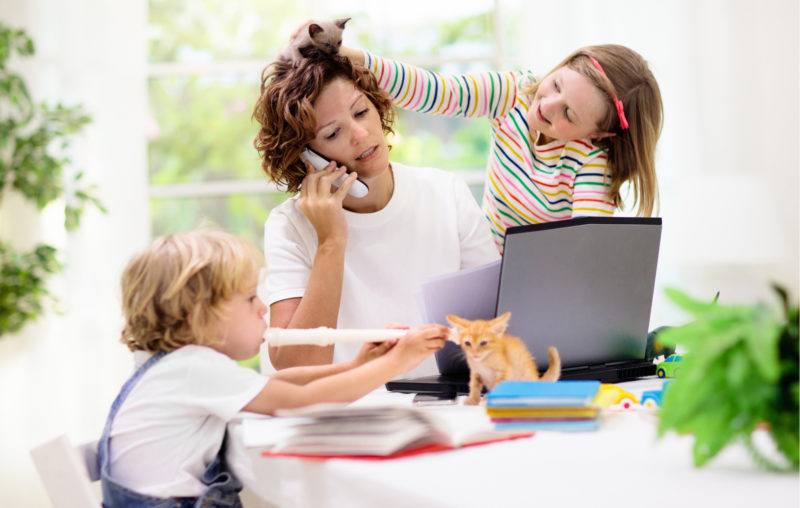This Pandemic Is Not Homeschooling’s Moment

Since the pandemic first picked up steam, over 1 billion students around the world have experienced educational disruptions of one form or another. In the United States alone, at the strictest point of closures, at least 55.1 million students in K-12 public and private schools were affected. Many kids, for the first time in their lives, engaged in remote learning.
The popular media jumped on the seemingly obvious conclusion that the nation’s children were now participants in a grand homeschooling experiment. NPR offered an instructional guide of “Tips For Homeschooling During Coronavirus” and the New York Times walked parents through “Figuring Out Home Schooling in the Age of Coronavirus.”
Ardent supporters of school choice were only too happy to join them in identifying this epoch as one in which we all, miraculously, became homeschoolers.
But this association could deal homeschooling a death blow, damaging its reputation beyond repair. As allies to homeschooling glowed, parents proclaimed “this is hell” and students completed assignments over McDonald’s WiFi en masse. COVID-era education proved so traumatizing that the Washington Post warned, “Homeschooling during the coronavirus will set back a generation of children.” Clearly, many are concerned.
Homeschooling is a system to be celebrated, to be sure. But to say that COVID-era measures created a homeschooled nation is a truly dangerous claim––and critics and proponents of homeschooling alike would be wise to amend their narrative.
Homeschooling is an educational pathway rooted in agency, something that the pandemic robbed families of. Its very premise is choice. Parents educate their children at home so they can develop an individualized curriculum, employ alternative instructional methods, and provide a more harmonious and compassionate learning setting. The system is based on nurture and collaboration and is deeply responsive to the needs of each student it serves.
Compare that to the state of COVID-era “homeschooling.” Often with just days’ notice, kids were relegated to their rooms with nothing more than worksheets, fragmented Zoom calls, and unrealistic attendance expectations. A Common Sense Media survey conducted in March and April indicated that more than half of all American teenagers worried about keeping up with their schoolwork, and roughly a quarter connected with teachers less than once a week. If these students were to believe that they had been homeschooled, they would forever associate home education with the boredom, discomfort, and confusion they experienced as a result of a global pandemic.
In reality, homeschoolers are active players in their education. The system entrusts students with the freedom to pursue interests that might otherwise be stifled by top-down educational direction and blanket tactics employed in large classrooms. Passions have space to grow without being crowded out by lessons that students do not need or want.
Somewhat counterintuitively, kids who learn at home pursue countless educational opportunities in the real world. Classrooms take many forms for homeschoolers, be they museums, libraries, or national parks. Multidimensional learning teaches students how to interact with the real world and find educational value in any number of experiences. Students come to associate learning with far more than just school.
In contrast, COVID education has hardly been rooted in the real world. The cultural, historical, and social spaces that homeschoolers regularly incorporate into their educational plans are now largely closed to the public, with students across the U.S. limited to what they can access from their homes. Virtual resources are a critical component of modern homeschooling, but they are far from the entirety of the homeschool experience. The holistic, outward-facing ethos that so often shapes homeschool curriculum is absent from what the nation now considers homeschooling.
After facing so many obstacles, it seems inevitable that the academic performances of American students will have slipped come fall. The NWEA, an educational research organization based in Oregon, offered a dire assessment: Students will return to school with 70 percent of the learning gains they would otherwise make in reading, and under 50 percent of the progress they would have made in math. This decline is expected to be so severe that some academics have proposed that students repeat grades to compensate.
Michael J. Petrilli, president of the Thomas B. Fordham Institute, went so far as to recommend that roughly one-fifth of America’s students be held back. If we are to believe that we are now a nation of homeschoolers, shouldn’t these academic struggles at least hint at abysmal educational standards among homeschoolers?
Quite the opposite. Homeschoolers perform better on standardized tests––on the ACT, for example, the average score for homeschooled students is typically between 22 and 23 points (compared to the national average of 21), which lands these kids in the 65th percentile. This trend is just as visible grade-to-grade.
A 2011 Concordia University study compared the educational standards of public school students, structured homeschooling students, and unstructured homeschooling students in Canada across a variety of metrics and found that structured homeschoolers scored at least one grade level ahead of public schoolers in 5 out of 7 categories, half a year ahead in one, and maintained a slight edge in the last.
Indeed, there is plenty to praise.
But COVID-19 has revealed an invaluable truth: The virtues of homeschooling do not magically materialize whenever students stay home. On paper, having students complete public school coursework from home may have looked like an ideal combination. But in practice, it failed to capitalize on the benefits of either system. Both the socialization offered in traditional school settings and the autonomy endemic to homeschooling were lost in the chaos.
If homeschooling is to appear viable to the public, it must be something people choose. Otherwise, it will forever be remembered as a system that assaulted American families with newfound expenses and anxieties.
This is not a desirable image of homeschooling. Homeschooling is not characterized by rigid guidelines administered by outside bodies. It is not a system where passion dies, where students struggle to get excited about their education. It is not a one-way ticket to lower academic standards.
This was not homeschooling.
Proponents of alternative education would be wise to reflect on their praise of America’s forced experiment in “homeschooling.” Because while this experience may compel some parents to keep their kids at home, there will be millions of students who return to physical schools with nothing but disenchantment with a system that may have held all their answers.










